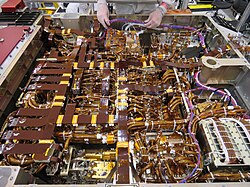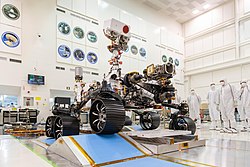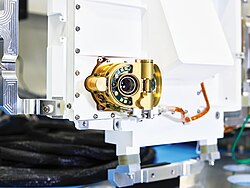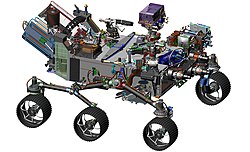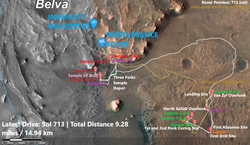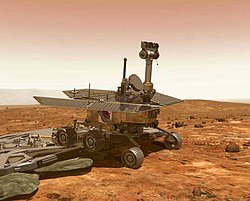PIA23306-Mars2020-Rover-MMRTG-20190724
The electricity for NASA's Mars 2020 rover is provided by a power system called a Multi-Mission Radioisotope Thermoelectric Generator, or MMRTG. Essentially a nuclear battery, an MMRTG uses the heat from the natural radioactive decay of plutonium-238 to generate about 110 watts of electricity at the start of a mission.
Besides generating electrical power, the MMRTG produces heat. Some of this heat can be used to maintain the rover's systems at the proper operating temperatures in the frigid cold of space and on the surface of Mars. This device, seen here before fueling and testing at the U.S. Department of Energy's Idaho National Laboratory, has "fins" that radiate excess heat.
MMRTGs are provided to NASA for civil space applications by the U.S. Department of Energy (DOE). The radioisotope fuel is inserted into the MMRTG at the DOE's Idaho National Laboratory before the MMRTG is shipped to the launch site. Electrically heated versions of the MMRTG are used at JPL to verify and practice integration of the power system with the rover.
JPL is building and will manage operations of the Mars 2020 rover for the NASA Science Mission Directorate at the agency's headquarters in Washington.
For more information about the mission, go to https://mars.nasa.gov/mars2020/.Relevante Bilder
Relevante Artikel
Mars 2020Mars 2020 ist die fünfte Mars-Rover- und erste Helikopter-Mission der NASA auf dem Mars. Mittels einer Atlas-V-Trägerrakete wurde am 30. Juli 2020 vom Cape Canaveral eine Landesonde mit dem Rover Perseverance mit seinem Kleinhelikopter Ingenuity („Einfallsreichtum“) auf den 480 Millionen Kilometer langen Flug zum Mars gestartet. Die Sonde landete am 18. Februar 2021 auf der nördlichen Marshalbkugel im Jezero-Krater, womit sie seit 1087 Sol aktiv ist. .. weiterlesen


